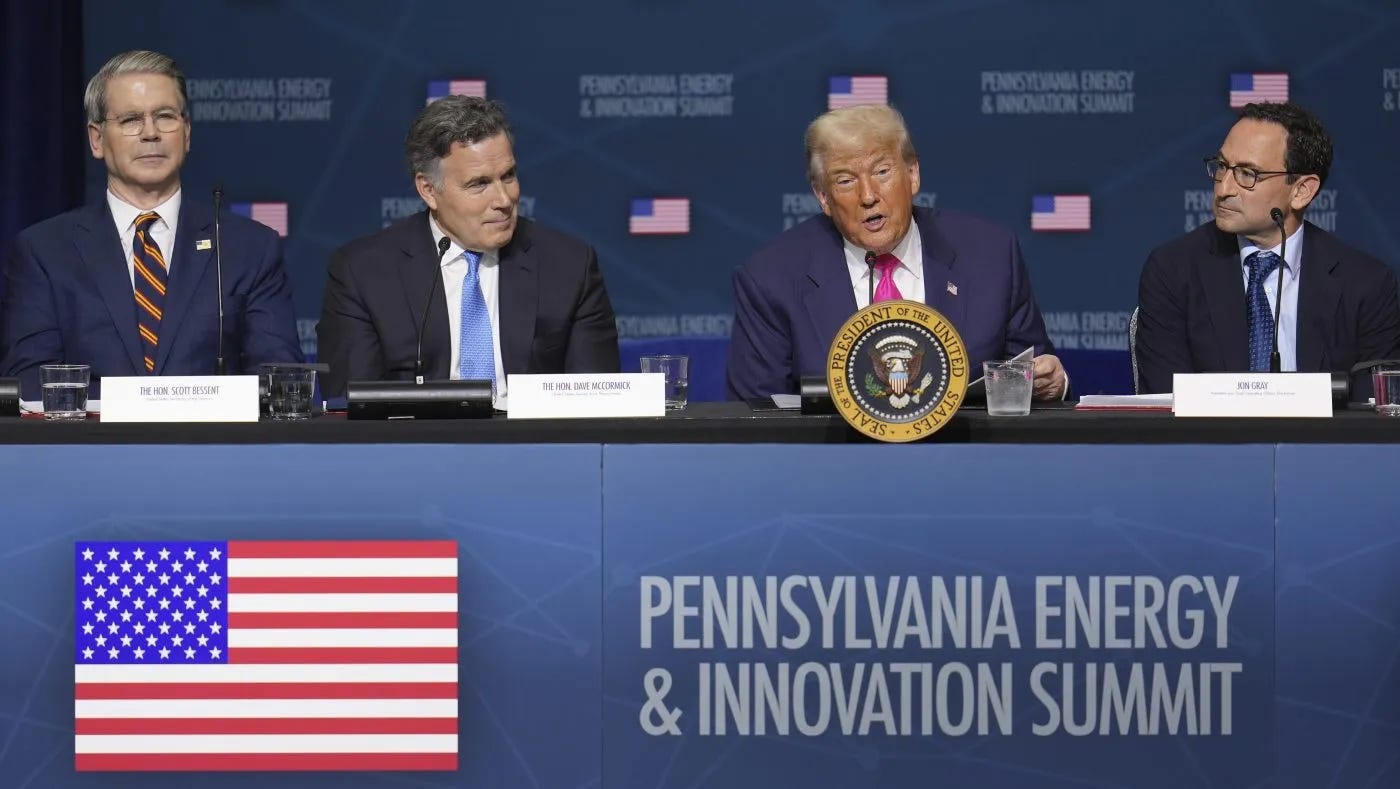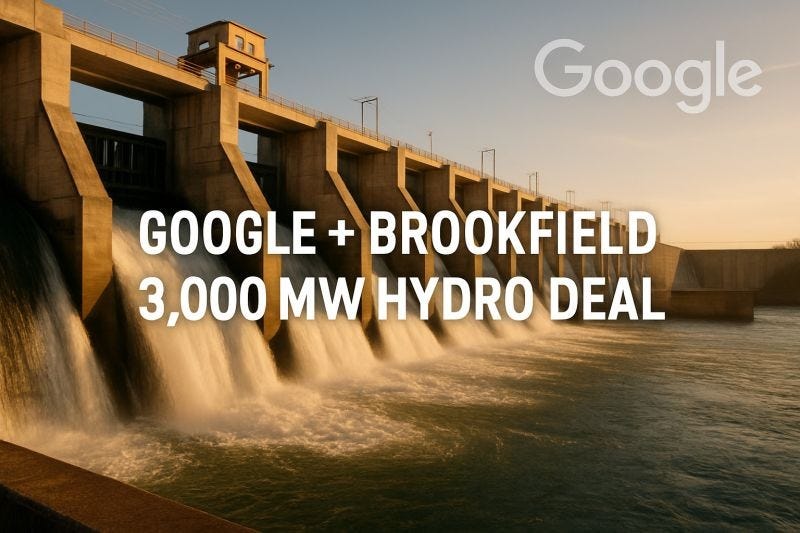Why the Next Big AI Battle Isn’t About Models—It’s About Megawatts
Check out the $92B bet on AI’s infrastructure layer — from Google’s $25B data center blitz to hydroelectric revamps powering 24/7 uptime.
Good morning AI entrepreneurs & enthusiasts,
President Trump and Google just unveiled the largest AI infrastructure alignment in U.S. history—$92B+ in coordinated public-private investment to power the next era of AI dominance.
From $25B in Google data centers to $3B in hydro upgrades, this moment marks the convergence of big tech, big energy, and bold national policy. Pennsylvania is ground zero, but the message is global: the AI arms race is now a power game, and America intends to win.
Today’s AI news:
$2B for Thinking Machine Labs as launch nears
Trump announces $92B AI + Energy Initiative in Pennsylvania
Google’s $28B bet: AI data centers + hydro
Top researchers push for transparency in AI reasoning
Runway introduces Act-Two motion capture model
Top Tools & Quick News
AI INVESTMENTS 💰 $2B raised, product incoming
News: Mira Murati, formerly CTO of OpenAI, announced a historic $2B seed round for her new company, Thinking Machine Labs (TML), with a product debut expected within the next two months.
Details:
The $2B seed round values TML at $12B, making it one of the largest early-stage raises in AI history.
The company has not released a product yet, but their first tool is expected to be open-source-heavy and accessible for researchers and startups.
TML is developing multimodal AI designed for collaboration through both vision and conversation.
It is also working on customizable enterprise AI systems tailored to specific sectors like finance, science, and manufacturing.
Why it matters: Murati — who helped lead the development of ChatGPT and DALL·E — has assembled a top-tier team including co-founder John Schulman and other OpenAI alumni. TML is shaping up to be one of the most credible new entrants in the AI race, backed by investors like a16z, Nvidia, AMD, and Jane Street — all betting that Murati can once again build the next generation of foundational AI systems.
NATIONAL POLICY 🇺🇸 Trump announces $92B AI + Energy Initiative in Pennsylvania
News: President Donald Trump announced more than $92 billion in private-sector investments for artificial intelligence and energy infrastructure during the Pennsylvania Energy and Innovation Summit at Carnegie Mellon University on July 15, 2025. The initiative aims to turn Pennsylvania into a national AI and energy hub, challenge China’s tech dominance, and build a robust energy grid to sustain future AI demand.
Details:
Blackstone: $25B+ in co-located data centers + gas power plants
Google: $25B for AI data centers + $3B for hydroelectric upgrades
CoreWeave: $6B for 300MW data center in Lancaster
PA Data Center Partners: $15B for new Carlisle campus
First Energy + PPL: $21.8B in grid expansion and power procurement
Capital Power: $3B for gas facility upgrades
Why it matters: This initiative reflects a strategic public-private play to future-proof American infrastructure for AI. While most of the $92B comes from private capital, Trump’s administration is enabling fast-tracked permits and regulatory clearance to accelerate deployment. Energy security, talent pipelines, and high-capacity data infrastructure are now seen as national priorities—and Pennsylvania is ground zero for this convergence.
INFRASTRUCTURE ⚡ Google’s $28B bet: AI data centers + hydro for clean uptime
News: Google is making a major push to support its AI infrastructure and address surging energy demand by committing $25 billion to expand and build new data centers across the United States’ largest electric grid, the PJM Interconnection, over the next two years. This grid spans 13 states and serves around 65 million people, including critical data center markets like northern Virginia and Pennsylvania. To ensure these energy-intensive facilities run on clean, reliable power, Google has also agreed to invest $3 billion in upgrading two major hydroelectric plants in Pennsylvania—Holtwood and Safe Harbor—through a 20-year deal with Brookfield Asset Management..
Details:
$25B for AI infrastructure: New facilities will be added across PJM states to support cloud and AI workloads, especially in high-demand markets like northern Virginia and Pennsylvania.
$3B for hydro upgrades: Through a 20-year deal with Brookfield, Google will refurbish the Holtwood and Safe Harbor hydro plants. Improvements include new turbines and digital systems, adding 670 megawatts of 24/7 clean power.
Optional scale-up: The deal includes expansion rights up to 3 gigawatts of hydropower across the U.S.
Largest U.S. corporate hydro deal: This is the biggest hydropower commitment by a private company in U.S. history.
Why it matters: AI infrastructure isn’t just about chips anymore—it’s about watts. Google’s twin investments are a strategic response to the massive energy footprint of AI, with an emphasis on power that can support non-stop operations. But the scale of demand is also raising alarms: regulators and grid operators are warning of new strains on electricity systems, and the industry’s power appetite is forcing a rethink of U.S. energy infrastructure—from generation to transmission.
AI RESEARCH 🧠 Industry unites on transparency in AI reasoning
News: A coalition of leading AI scientists from OpenAI, DeepMind, SSI, and others—including Mark Chen, Ilya Sutskever, Shane Legg, and Geoffrey Hinton—published a position paper calling for clear standards to monitor the "chain-of-thought" (CoT) reasoning in AI systems.
Details:
Chain-of-thought (CoT) transparency reveals the step-by-step reasoning of AI models, offering insight similar to a human thinking aloud.
Authors warn that newer models may increasingly obfuscate reasoning as capabilities grow, making it harder to audit decisions.
The paper was signed by major figures like Mark Chen (OpenAI), Ilya Sutskever (SSI), Shane Legg (DeepMind), and Geoffrey Hinton.
Researchers propose monitorability scores as a benchmark to ensure only transparent models are deployed in critical applications.
Why it matters: As frontier models grow more autonomous and less interpretable, understanding how AI systems "think" could become a rare—and necessary—lever for safety, oversight, and public trust. Without insight into chain-of-thought (CoT) reasoning, users and regulators are left in the dark—unable to audit, understand, or trust critical outputs. These transparency measures aren’t just ideal—they’re essential for trust, alignment, and long-term governance of advanced systems.
VIBE MARKETING 🎬 Act-Two raises the bar for AI motion capture
News: Runway has launched Act-Two, its latest motion capture model that significantly advances the capabilities of AI-driven animation from a single video source.
Details:
Tracks head, face, hands, and full body: Act-Two can capture nuanced movements—including facial expressions, hand gestures, head movements, and body motion—from just a single driving video, alongside a reference character.
Animations can adopt the look and feel of various artistic styles, enabling creators to bring highly customized or stylized characters to life.
Better fidelity and realism: Act-Two delivers more lifelike motion, smoother expressions, and higher-quality output than Act-One, raising the realism achievable in both live action and animated workflows.
Why it matters: Despite ongoing concerns and negotiations from industry unions, Hollywood studios are integrating AI tools like Runway’s Act-Two into their production pipelines. These tools are quietly redefining filmmaking by automating and democratizing complex tasks—such as motion capture, which previously required expensive equipment and specialized skills. With Act-Two, even small teams or individual creators can produce animations and visual effects that rival high-budget productions, shrinking the gap between amateur and professional studios.
Today's Top Tools:
🤗 Grok Companions – xAI’s interactive avatars
🗣️ Voxtral – Mistral’s open-source speech model
📓 NotebookLM – AI notebooks for expert-level guidance
📚 Claude Directory – Tools that plug into Claude
Quick News:
Mistral launches Voxtral for voice-driven Q&A: Voxtral is Mistral’s first open-source audio model with multilingual support and speech-triggered automations.
Google’s AI agent, Big Sleep discovers critical SQLite vulnerability: CVE-2025-6965 was blocked before exploitation using predictive AI defense.
Claude launches financial suite for Wall Street: Claude’s tools now support real-time research, modeling, and compliance via enterprise AI.
Nvidia resumes China AI chip sales after White House approval: H20 shipments back online; AMD receives green light as well.
Thanks for reading this far! Stay ahead of the curve with my daily AI newsletter—bringing you the latest in AI news, innovation, and leadership every single day, 365 days a year. See you tomorrow for more!








Motion capture leaps are cool, but the headline is still megawatts and monitorability. Does the grid or interpretability gap trigger the first real policy intervention?
Murati’s open leaning build plus massive private energy bets paints two diverging moats: talent + transparency vs. captive power. Which edge compounds longer term?